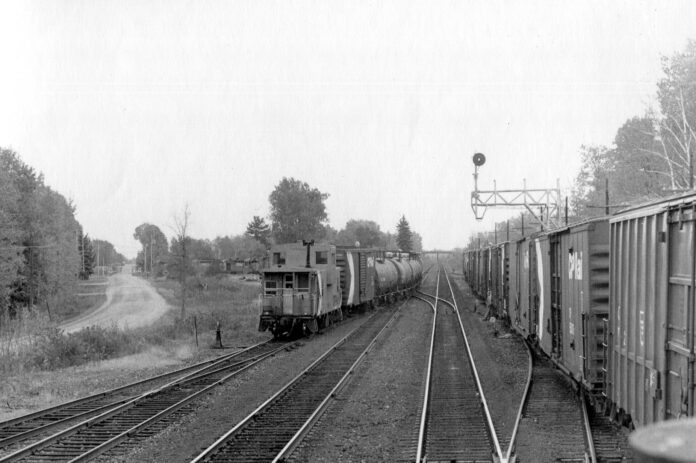by Craig Stevenson
A photo of the near past spurs thoughts of railway evolution at Bedell.
The view is enticingly familiar but largely gone—and it reflects a world that has changed immensely in a short span of time. This photograph of the Bedell rail junction surfaced recently on a social media page devoted to regional railway interests. It was taken on October 13, 1993, by railway photographer Michael Shufelt, a frequent visitor to the area in the 1990s.
Its emergence is timely. Bedell is changing, as is the Canadian Pacific line between Smiths Falls and Montreal. The signal system has been updated and the line has, along most of this distance, been reduced from a double to a single track. Bedell is also being cleansed of those remnants of its earlier life as a junction of rail lines that connected various eastern Ontario communities.
The photo looks east toward the junction and is taken from a vantage point on the south track not far from where Bedell Road now crosses the line. The road surface is still gravel, and the fringe of land between the road and the rail lines is not yet overgrown with brush.
The first two tracks on the left are the sidings for rail cars being taken to and from Ottawa. Here we see a local freight—the “Ottawa turn”—taking a string of cars off the siding, onto the mainline, and then turning onto the single track of the “Prescott subdivision”. In the distance—and to the immediate left of the caboose at the rear of the train—the locomotives are approaching the level crossing where the track crosses Bedell. From there, the train will enter Kemptville to move a car or two at the line into the Co-op feed mill on Van Buren before continuing to Ottawa.
Rail freight between Bedell and Ottawa ceased in 1997, and this line is now the “rail trail” through Kemptville. Aside from remnant telegraph poles and scattered bits of rotting wooden ties, only the railbed itself reminds the trail walker of this pathway’s previous life.
And those sidings to the rear of the caboose? Long out of freight service, CP parked maintenance-of-way equipment on them until last year, when they were severed from the main line as part of the current modernization project. In early November, the rails were lifted, leaving behind a scarred line of ties. The switch stand immediately behind the caboose is still in place, a small monument of sorts to the junction’s past life.
Down the middle of the photo is a familiar sight—the County Rd 44 overpass—and a now-removed “crossover” track. The double-tracked mainline remains here, though technically the north (left) track is a passing siding, one of several between Smiths Falls and Montreal facilitating the passage of trains moving in opposing directions.
To the right, a line of boxcars occupies the nearest of two south siding tracks. This siding track remains as a parking spot for work trains operating in the area. The most notable feature here is the cantilever signal bridge looming over the line of cars. That signal bridge features in Bedell photos dating back to the era of the steam locomotive. It stood as a disused but notable landmark of the junction until early November, when it too was torn out. Its crumpled length currently lies at the edge of the Bedell yard.
Along the boxcar tops can be seen the crossarms of the old telegraph system, as dead to use then as they are now. Today, they are largely hidden by overgrowth. To their right, the turnoff to the old Prescott line remains in abbreviated form as a short industrial line south to Oxford Station.
The cumulative visual effect contrasts with what one sees at Bedell today. Aside from east-west mainline rail traffic, only the local train to Oxford Station allows the site to qualify as a junction of any sort. That reflects another story—one of broader technological and economic change. For as an economy goes, so goes the structure and scale of its supporting infrastructure.
So long as those vestiges of the past remained, it was possible to see the character of a world that has disappeared rapidly in the past two decades. The newly-scrubbed scene is one of technological efficiency, and a telling sign of an economy that has jumped up to a global scale. Today’s Bedell is little more than a backdrop to a rail system connecting Montreal and Saint John to Toronto and Chicago and Vancouver.
This too has consequences. The realignment of the CP system also reflects the wave of de-industrialization that has swept eastern Ontario and beyond, producing economic dislocation, manufacturing unemployment, and much of the political turmoil characteristic of our age.
And in that, this view of an everyday scene is a revealing look at so much more than trains.








A few short line railways operate in Ontario but the big boys (and girls) want the long runs where they can make more money, Having said that the short lines, managed properly can do quite well feeding in the larger rail operations. I keep an eye on a rail operator (Ontario Southland Railway) which appears to do quite well thanks to its local customers, some of who are quite large in the business world. That is all I will say,